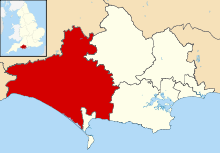Bettiscombe
| Bettiscombe | |
 Parish church of St Stephen |
|
 Bettiscombe |
|
| Population | 50 [1] |
|---|---|
| OS grid reference | ST395005 |
| District | West Dorset |
| Shire county | Dorset |
| Region | South West |
| Country | England |
| Sovereign state | United Kingdom |
| EU Parliament | South West England |
Coordinates: 50°47′46″N 2°51′18″W / 50.7962°N 2.8549°W

Bettiscombe is a small village and civil parish in west Dorset, England, situated in the Marshwood Vale 4 miles (6.4 km) west of Beaminster. Dorset County Council's 2013 mid-year estimate of the population of the civil parish is 50.[1]
History
The parish church, dedicated to St Stephen, has two windows in the chancel, and possibly one in the west tower, that date from about 1400, though the rest of the building was rebuilt in 1862.[2]
Skull legend
Bettiscombe Manor, a manor house in the village, is known as "The House of the Screaming skull" due to a legend dating from the 17th century. Other ghost stories are also associated with the manor.
The legend maintains that the skull is that of a Jamaican slave. John Frederick Pinney disposed of the Nevis estates and returned to the family home of Bettiscombe Manor in the early nineteenth century, accompanied by one of the family's faithful black servants. While in his master's service, the servant was taken seriously ill with suspected tuberculosis. As he lay dying, the servant swore that he would never rest unless his body was returned to his homeland of Nevis, but when he died, John Frederick Pinney refused to pay for such an expensive burial and instead had the body interred in the grounds of St. Stephen's Church cemetery. After the burial, ill fortune plagued the village for many months and screams and crying were heard coming from the cemetery. Other disturbances were reported from the manor house, such as windows rattling and doors slamming of their own accord. The villagers went to the manor to seek advice. The body of the servant was exhumed and the body taken to the manor house. In the process of time the skeleton has long since vanished, except for the skull where it has remained in the house for centuries.
In 1963 a professor of human and comparative anatomy at the Royal College of Surgeons stated that the skull was not that of a black man but that of a European female aged between twenty-five and thirty.[3]
See also
References
- 1 2 "Parish Population Data". Dorset County Council. 20 January 2015. Retrieved 24 February 2015.
- ↑ "'Bettiscombe', in An Inventory of the Historical Monuments in Dorset, Volume 1, West (London, 1952), pp. 28-29". British History Online. University of London. Retrieved 11 May 2015.
- ↑ Roland Gant (1980). Dorset Villages. Robert Hale Ltd. p. 111. ISBN 0-7091-8135-3.
